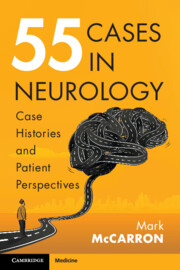Book contents
- 55 Cases in Neurology
- 55 Cases in Neurology
- Copyright page
- Contents
- Preface
- Acknowledgements
- Section 1 Visual Disturbance
- Section 2 Headache and Pain
- Section 3 Weakness
- Section 4 Behavioural and Language Changes
- Section 5 Confusion
- Section 6 Movement Disturbances
- Case 38 Involuntary Arm Movement
- Case 39 Salt Control
- Case 40 A Young Man with More Than Dizziness
- Case 41 Late Familial Falling
- Case 42 Non-familial Falling
- Case 43 Shaking Leg
- Case 44 A Viral Opportunity
- Case 45 More Searching for Causes of Progressive Unsteadiness
- Section 7 Acute Onset of Neurological Symptoms
- Index
- Plate Section (PDF Only)
- References
Case 38 - Involuntary Arm Movement
from Section 6 - Movement Disturbances
Published online by Cambridge University Press: 27 July 2023
- 55 Cases in Neurology
- 55 Cases in Neurology
- Copyright page
- Contents
- Preface
- Acknowledgements
- Section 1 Visual Disturbance
- Section 2 Headache and Pain
- Section 3 Weakness
- Section 4 Behavioural and Language Changes
- Section 5 Confusion
- Section 6 Movement Disturbances
- Case 38 Involuntary Arm Movement
- Case 39 Salt Control
- Case 40 A Young Man with More Than Dizziness
- Case 41 Late Familial Falling
- Case 42 Non-familial Falling
- Case 43 Shaking Leg
- Case 44 A Viral Opportunity
- Case 45 More Searching for Causes of Progressive Unsteadiness
- Section 7 Acute Onset of Neurological Symptoms
- Index
- Plate Section (PDF Only)
- References
Summary
A 71-year-old woman with a history of type 2 diabetes mellitus developed involuntary movements of her left arm and left leg. These were predominantly proximal, irregular, unpredictable, purposeless and at times had a ballistic or explosive and large amplitude pattern. The movements stopped during sleep. She associated the involuntary movements with the onset of pain in her first carpo-metacarpal joint. A local anaesthetic-steroid injection had helped ease the pain. Her diabetic control had recently deteriorated.
- Type
- Chapter
- Information
- 55 Cases in NeurologyCase Histories and Patient Perspectives, pp. 263 - 268Publisher: Cambridge University PressPrint publication year: 2023



